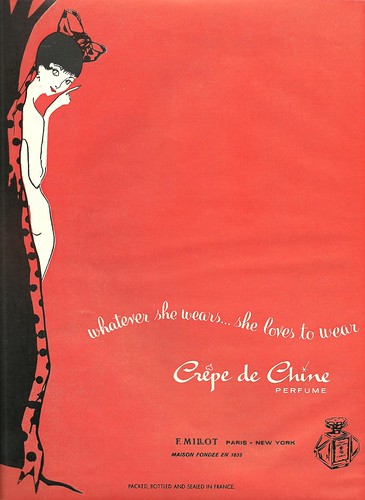Crêpe de Chine
I always imagined Crêpe de Chine to be a dark, mysterious, ineffable creation that I would only admire from afar when I finally encounter him (I thought of this perfume as a very serious masculine creature, perhaps a very severe fashion designer constructing accurately flowing evening gowns from this particular fabric). Non of this turns out to be the truth about Crêpe de Chine (except that its beauty is indeed ineffable!). A vintage half-full bottle of the eau de toilette landed in my mailbox two evenings ago as part of a swap with a perfumiso from the Netherlands, and added a lot of beauty to every moment of my life since I could not stop applying and re-applying. The vintage bottle itself is also easy on the eyes (though a bit too generous with spilling out its precious jus to the sides of the spray nozzles every time I apply a spritz or too - a sure sign that bottle designs have improved in the past 50 years or so - Crêpe de Chine went off production in 1968, a few years after Millot was purchased by Revillon).

Nothing could have prepared me to what Crêpe de Chine would smell like. But, I didn't really need any preparation: Crêpe de Chine was one of the very rare cases of love at first sniff, with a very complex perfume. It begins with a burst of laughter, emanating from a rush of galbanum, crushed sweet basil and zesty citrus! I'm surprised these vibrant notes managed to remain in the bottle after all these years and remain true to their zestiness. Playful, cheerful, bitter-green but not intimidating or formal at all (which is often the vibe that one gets from cool, bitter greens).
Moving quickly to the heart of Crêpe de Chine, deeper notes of incense and hints of smoky leather begin to swirl around the skin, and this warmth stayed with me for hours, lingering like the remnants of an ancient ritual, omitting the charred aftermath. Sensual and reassuring, like a quiet reminder to breath in the beauty around us! The fine aroma of lingered fragrant smoke kept weaving through my aura, making me smile every time. This incense effect is achieved, I believe, from the conjunction of fine, santalol-rich East Indian Sandalwood (now extinct), aged Indonesian patchouli, the resinous-leather-incense-amber of labdanum, and musk.
Weaving through the wafts of incense, earthy and warm aromas of forest floor and sun-warmed hills bring grounding. Labdanum and oakmoss, surrounded with the spice of carnation and hints of cinnamon. Ahh... How I love the roundedness, complete mystery of Chypre! No one note truly sticks out, though I'm certain there are plenty of florals to support this very abstract structure.
Finally, we come to the drydown, or deepest base notes. Here the sweetness of earth and sunny rockroses is replaced by the bittersweetness of coumarin (could be from tonka beans, but most likely supported by the first synthetic aromachemical used in perfume history), paired by non other than clean and dry vetiver. That's a balanced duo, and a very surprising finish to a masterpiece olfactory tale with many twists and turns. At which point, you wonder if it isn't a fougere after all... And indeed, like some other reviewers of Crêpe de Chine, it is suitable for men to wear and enjoy without worrying about smelling like a bouquet of flowers or a lacy hosiery.
Top notes: Galbanum, Basil, Fresh Aldehydes, Lemon, Bitter Orange, Bergamot
Heart notes: Carnation, Jasmine, Gardenia, Ylang Ylang, Rose, Cinnamon, Roman Chamomile
Base notes: East Indian Sandalwood, Musk, Oakmoss, Vetiver, Indonesian Patchouli, Leather/Smoky Notes, Labdanum, Musk
For other reviews of Crêpe de Chine visit:
The Non-Blonde
Now Smell This
Yesterday's Perfume



